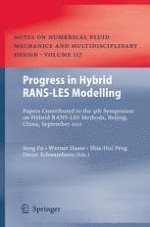The present book contains contributions presented at the Fourth Symposium on Hybrid RANS-LES Methods, held in Beijing, China, 28-30 September 2011, being a continuation of symposia taking place in Stockholm (Sweden, 2005), in Corfu (Greece, 2007), and Gdansk (Poland, 2009). The contributions to the last two symposia were published as NNFM, Vol. 97 and Vol. 111. At the Beijing symposium, along with seven invited keynotes, another 46 papers (plus 5 posters) were presented addressing topics on Novel turbulence-resolving simulation and modelling, Improved hybrid RANS-LES methods, Comparative studies of difference modelling methods, Modelling-related numerical issues and Industrial applications.. The present book reflects recent activities and new progress made in the development and applications of hybrid RANS-LES methods in general.
